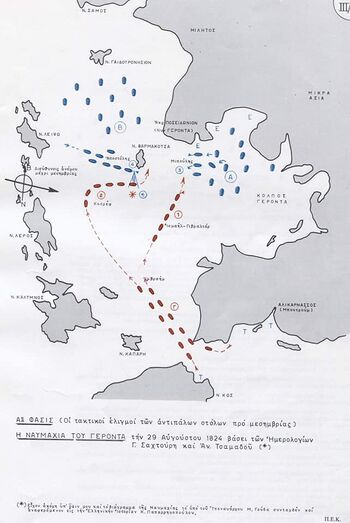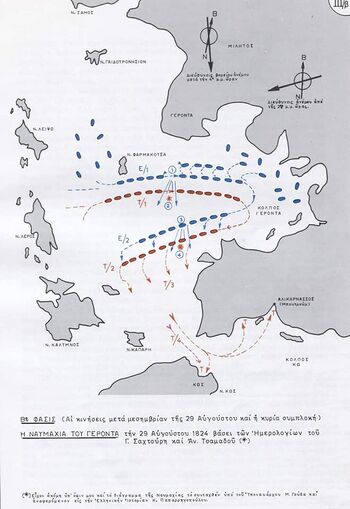معركة بودروم (1824)
| معركة بودروم | |||||||
|---|---|---|---|---|---|---|---|
| جزء من حرب استقلال اليونان | |||||||
 معركة الرجل العجوز البحرية | |||||||
| |||||||
| المتحاربون | |||||||
|
|
| ||||||
| القادة والزعماء | |||||||
| أندرياس مياولوس |
خسرو باشا ابراهيم باشا | ||||||
| الوحدات المشاركة | |||||||
| أسطول ساموس | |||||||
| القوى | |||||||
| 70 سفينة[1] |
200 سفينة مصرية 50 سفينة تركية | ||||||
معركة بودروم، هي معركة بحرية وقعت في 29 أغسطس 1824 بين قوات الثوار اليونانيين والبحرية العثمانية بقيادة خسرو باشا والمصرية بقيادة ابراهيم باشا.[2]
أحداث المعركة
بعد هزيمة العثمانيين في معركتي ساموس وجرونتاس البحرييتين وتفرق الأسطولين المصري والعثماني بعد خسارتهما بعض السفن على يد القوات اليونانية، عاد ابراهيم باشا بأسطوله إلى ميناء بودروم.[3]
تراجعت العمارة التركية جنوبا حتى التقت بالعمارة المصرية في مياه بودروم كما أسلفنا.
هاجمت السفن اليونانية العمارتين بالقرب من بودروم ودارت رحى القتال بين الفريقين، فلاذ الاسطول التركي بالفرار من الميدان، أما ابراهيم باشا فقد صمد للسفن اليونانية حتى اضطرها الى التقهقر (سبتمبر سنة 1824).
واتصلت العمارتان المصرية والتركية ثانيا وسارتا الى مياه جزيرة مدللي ثم تابعت العمارة التركية سيرها شمالا الى الدردنيل.
ورجع الاسطول المصري جنوبا، فاعترضته السفن اليونانية في مياه جزيرة ساقز واشتبكت به في معركة شديدة افضت الى غرق سفينتين مصريتين (أكتوبر سنة 1824) ثم عاد ابراهيم باسطوله الى ميناء بودروم.
أدرك ابراهيم باشا من هذه الوقائع أن هزيمة اليونان لا تكون على ظهر البحر حيث لهم السفن المنبثة في نواحيه، وأن خير وسيلة للغلبة عليهم هي القضاء عليهم برا في شبه جزيرة الموره، فرجع ادراجه الى ميناء مرمريس جنوباً، ثم اقلع الى جزيرة كريت في ديسمبر سنة 1824 ورسا بالعمارة في خليج سودة حيث اخذ يتحين الوقت المناسب للاقلاع الى ساحل المورة.
ولقد برهن ابراهيم باشا خلال هذه الوقائع البحرية على شجاعته التي امتاز بها في حروب البر ، فانه صمد عدة أشهر لقتال السفن اليونانية التي اشتهرت بعظيم قدرتها في خوض غمار البحار ومهارتها في مهاجمة السفن الحربية، ولولا عزيمته ورباطة جأشه في مواجهته المخاطر لتشتت العمارة المصرية وتبددت امام هجمات السفن اليونانية، قال المسيو داون في هذا الصدد:
"مضت خمسة أشهر على مغادرة العمارة المصرية ثغر الاسكندرية، خمسة أشهر تقضت في جهود شاقة، ومتاعب لا هوادة فيها، ومخاطر تجدد كل يوم، وان ما ابداه ابراهيم باشا في هذه الظروف من الثبات ورباطة الجأش لما يسترعي النظر، فان قيادة اسطول بحري تصحبه عمارة من سفن النقل لمن المهام التي لا يسهل الاضطلاع بها، وان ابراهيم باشا في قيادته عمارة من مائة سفينة تقل نحو عشرين ألف رجل من جنود وبحارة قد اضطلع بمثل المهمة التي حملها بونابرت من قبل، مع حفظ النسبة بين الموقفين، حينما اجتاز البحر الابيض في اواخر القرن الماضي بعمارة من 280 سفينة تقل 38000 مقاتل، واذا تذكرنا ان مصر لم يكن لها الى ذلك الحين اسطول منتظم، ولا تقاليد بحرية، ولا هيئة من الضباط البحريين الاكفاء ولا العدد الكافي من البحارة المدربين، وكان على ابراهيم باشا ان يبتكر وينظم على الفور كل ما يلزم الحملة البحرية من سفن حربية وسفن للنقل، ورجال وعتاد، وان يروض نفسه على ركوب البحر والقتال بين أمواجه وأهواله، اذ تذكرنا كل ذلك، فانه يحق لنا ان نعجب كيف ان العمارة التي حشدها محمد علي امكنها ان تبقى خمسة أشهر تجوب البحار دون ان تتفكك أوصالها، وكيف استطاعت ان تثبت امام الوثبات والهجمات الشديدة التي استهدفت لها واصابتها من عدو له حظ كبير من المهارة من غير ان تخسر سوى سفينتين حربيتين وبضعة نقالات. لا شك ان هذه الحقائق تدلنا على مضاء عزيمة ابراهيم باشا وعلو همته، وتطالعنا بما تحتويه نفسه من صفات العظمة ومزايا الرياسة والقيادة، كما ان موافقته في ميادين القتال ورباطة جأشه في مغالبة المحن تدل على شجاعة كبرى لا يسع أي انسان الا أن يبادر بالاعجاب بها".[4]
الرواية اليونانية
The Greek squadrons, which protected Samos, after the departure of the Sultanic Fleet set sail: the Hydra to the north of the island of Lipso, and the Spetsian to Patmos. Miaoulis with the greater part of the Fleet, which was patrolling the South Aegean, as soon as he was informed that the Sultan's Fleet had sailed to Kos and that the Egyptian had arrived, sailed to the island of Lipso and joined the Hydra fleet, while the Spetsian fleet arrived a little later .
The combined Ottoman (Egyptian-Sultanic) Fleet included about 100 warships (of which 1 dicroto, 20 frigates, 25 corvettes, 50 hemiolies), which carried 8,000 sailors, 2,500 soldiers and 2,500 guns. He was accompanied by about 400 ships carrying 8,000 soldiers and 1,000 horsemen. The Greek Fleet, on the other hand, consisted of about 70 ships, mainly parones and semiolias with 5,000 men and 800 cannons, as well as many pyrotechnics.
On August 24, the Kos-Halicarnassus Battle took place, which had no clear outcome and was interrupted by night and storm. The Ottoman Fleet anchored in the Bay of Halicarnassus-Bodrum and the Hellenic Fleet, in the Gulf of Gerontas, in order to prevent any possible aggressive action by the enemies in Samos. On August 29, the Naval Battle of Gerontas took place, during which the genius of Miaoulis shone, overcoming the disadvantages - such as the lack of a favorable wind and the dispersion of the fleet in the area - and led the Greek Fleet to victory. The incendiary guns also made a significant contribution, as they caused damage and panic to the enemy.
The enemies, however, despite their defeat, tried again to attack Samos, but again for ten days the Greek Navy repelled the Ottoman Fleet. After these setbacks, the Sultan's Fleet sailed to the Dardanelles, while the Egyptian to Kos, where Ibrahim replenished his army and punished some governors, considering them to have failed in their duty. Then, he headed for Crete.
Twelve miles north of Heraklion, the Egyptian Fleet collided with the Hellenic Fleet under Miaoulis and suffered a crushing defeat. Miaoulis took advantage of the fact that the enemy fleet was divided into two divisions; the first was a squadron of men-of-war accompanying the transports, while the second consisted of 12 twelve large frigates under Ibrahim. The Naval Battle of Northern Crete took place on November 2 and took place in two phases, one in the morning and one in the evening. The Egyptian Fleet, although superior in armament, number and size of ships due to the skillful handling of the Greeks, quickly lost morale. Even Ibrahim himself was horrified - distraught and confused. The result was Ellinikos
Fleet to begin in pursuit of the Egyptian ships, while they in confusion cannonade one another.
Interpretative Memoir of the Battle of the Elder Naval Battle of the Elder – phase 1, the maneuvers of the fleets before noon Date: 29 August 1824
Opponents: The Hellenic Fleet, under the general command of A. Miaoulis, consisted of 70 ships, mainly parones and semiolias as well as a number of fire-powered ships. The Greek warships were equipped with 800 guns and manned by 5,000 men. The united Ottoman Fleet was as follows: the Sultan Fleet under the command of Khosref, the Egyptian under Ismail-Gibraltar, while the general command was held by Ibrahim Pasha. The Ottoman Fleet consisted of 100 ships, of which 1 dikrot, 20 frigates, 25 corvettes and 44 parones. These were equipped with 2,500 guns and manned by 8,000 sailors and 2,500 soldiers. Ibrahim Pasha's purpose was to engage the Greek Fleet and then capture the island of Samos. Then, he would end the Revolution in the Peloponnese.
E, E, E: Anchorages of the Greek Fleet. T, T, T: Anchorages of the united Ottoman Fleet.
A: 22 Greek ships, among which those of Shaktouri, Topazis, Tsamados, etc., under Miaoulis, dispersed within the Gulf of Gerontas due to apnea. B: about 50 Greek ships scattered between the islets of Leipsos, Farmakoussa and Gaidoronisi. C: The Ottoman Fleet under Ibrahim, having sailed the Kos-Halicarnassus strait, moves north to rendezvous with the Greek.
1: The right part of the Ottoman Fleet under Ismail-Gibraltar tries to cut off the Greek ships in the bay. 2: The left division under Khosref moves to attack the Greek ships that were in the islets of Lipso and Farmakusa. 3: Greek ships under Miaoulis manage, after towing them with boats, to leave the bay and set sail. 4: Greek ships under Apostolis, as soon as the wind permitted, move to meet Miaoulis. 5: A group of three fireballs (Pippinus and Nicodemus two) unsuccessfully attack the headquarters of Khosref, who with his squadron had opened fire against the squadron of Apostolis, with the aim of preventing its union with Miaoulis.
THE NAVAL BATTLE OF GERONDA PHASE 2 (August 29, 1824)
The Old Man's Naval Battle - Phase II, mainly post-midday engagement Opponents: As above. E/1 and T/1: Positions of opposing fleets at one p.m. (13.00). The fleets have joined and the close range artillery engagement begins.
1: Position from which the fire brigade attack under Matrozos, Vatikiotis and Moussou begins, against the enemy line. An enemy parson is set on fire.
2: The enemy paron ignites. E/2 and T/2: Positions of opposing fleets at four p.m. (16.00), after the reversal of the Ottoman Fleet, as a result of the fireball attack.
3: Position from which the second attack of the fire brigade under G. Papantoniou and G. Theoharis begins.
4: The Tunisian frigate of 44 guns that was set on fire by the Greek gunboats and mainly by Theoharis. T/3: The Ottoman Fleet in confusion after the fireball attack turns south and withdraws from the naval battle. T/4: The Ottoman Fleet, pursued by Hellinikon, sails the Kos-Halicarnassus Ferry in the afternoon and finds refuge in its anchorages in the coves.
Photo: subprints of phases 1 and 2 of the Old Man's Naval Battle.
المصادر
- ^ "On August 29, 1824, the glorious Naval Battle of Gerontas took place". pontos news. 2021-08-29.
- ^ "August 29, 1824: The Old Man's Naval Battle". infognomonpolitics.gr. 2020-08-29.
- ^ الرافعي, عبد الرحمن (2009). عصر محمد علي. القاهرة، مصر: دار المعارف.
{{cite book}}: Cite has empty unknown parameter:|coauthors=(help) - ^ الرافعي, عبد الرحمن (2009). عصر محمد علي. القاهرة، مصر: دار المعارف.
{{cite book}}: Cite has empty unknown parameter:|coauthors=(help)



